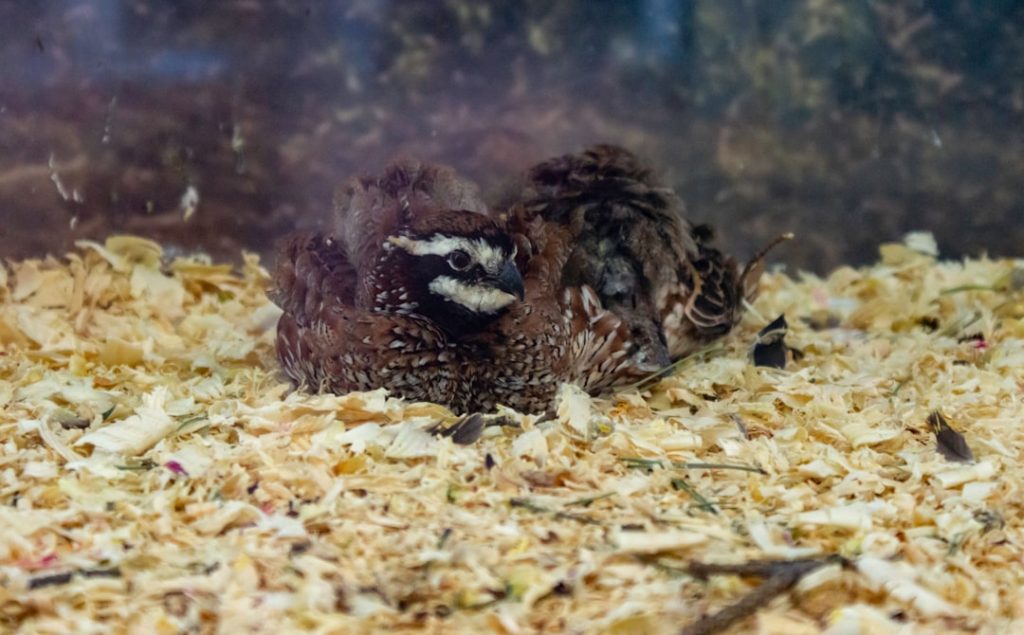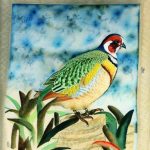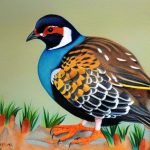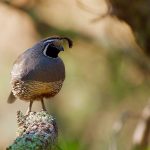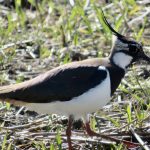Mearns quail, also known as Montezuma quail, are a unique and beautiful species of quail that are native to the southwestern United States and northern Mexico. They are known for their striking appearance, with intricate black and white markings on their plumage, and their distinctive call, which sounds like a series of whistling notes. Mearns quail are a popular choice for breeders and enthusiasts due to their stunning appearance and relatively calm demeanor. They are also known for their adaptability to a variety of environments, making them a great choice for both hobbyists and commercial breeders.
Mearns quail are ground-dwelling birds that prefer to live in areas with dense vegetation and ample cover. They are often found in grasslands, shrublands, and desert scrub habitats. In captivity, it is important to provide them with a habitat that mimics their natural environment as closely as possible. This includes providing plenty of hiding spots, such as dense vegetation or artificial shelters, as well as access to a variety of natural foods, such as seeds, insects, and small invertebrates. Mearns quail are also known for their social nature, so it is important to keep them in small groups to prevent stress and aggression. With the right care and attention, Mearns quail can thrive in captivity and provide breeders with a rewarding and enjoyable experience.
Table of Contents
- 1 Selecting Breeding Stock
- 2 Housing and Care
- 3 Breeding and Incubation
- 4 Rearing Chicks
- 5 Health and Disease Management
- 6 Selling and Marketing Quail
- 7 FAQs
- 7.1 What is the breeding season for Mearns quail?
- 7.2 How do Mearns quail build their nests?
- 7.3 How many eggs do Mearns quail typically lay?
- 7.4 How long does it take for Mearns quail eggs to hatch?
- 7.5 What is the role of the male Mearns quail in the breeding process?
- 7.6 What is the mortality rate for Mearns quail chicks?
Key Takeaways
- Mearns quail are a popular game bird known for their distinctive appearance and behavior, making them a desirable choice for breeders and hunters alike.
- When selecting breeding stock, it is important to choose birds with good health, strong genetics, and desirable traits such as size, color, and temperament.
- Proper housing and care for Mearns quail includes providing a spacious and secure enclosure, a balanced diet, and regular health checks to ensure their well-being.
- Breeding and incubation of Mearns quail involves creating the right conditions for mating, collecting and storing eggs, and using an appropriate incubator to hatch the eggs.
- Rearing chicks requires careful attention to their diet, temperature, and socialization to ensure their healthy development and eventual integration into the adult flock.
- Health and disease management for Mearns quail involves regular monitoring for signs of illness, implementing biosecurity measures, and seeking veterinary care when necessary.
- Selling and marketing Mearns quail can be done through various channels such as direct sales to hunters, supplying to game farms, or participating in bird shows and exhibitions.
Selecting Breeding Stock
When it comes to selecting breeding stock for Mearns quail, there are several important factors to consider. First and foremost, it is important to choose birds that are healthy and free from any genetic defects or diseases. This can be determined through a thorough examination of the birds’ physical appearance, behavior, and overall condition. It is also important to select birds that exhibit the desired traits for breeding, such as strong and vibrant plumage, good body conformation, and a calm and friendly demeanor.
In addition to physical traits, it is also important to consider the birds’ genetic background when selecting breeding stock. This includes researching the birds’ lineage and breeding history to ensure that they come from healthy and genetically diverse stock. This can help to prevent inbreeding and maintain the overall health and vitality of the breeding population. Finally, it is important to consider the birds’ reproductive history when selecting breeding stock. Birds that have successfully bred in the past are more likely to produce healthy offspring, so it is important to choose birds with a proven track record of successful breeding. By carefully selecting breeding stock based on these factors, breeders can ensure that they are working with healthy, genetically diverse, and reproductively successful birds.
Housing and Care
Proper housing and care are essential for the health and well-being of Mearns quail in captivity. When it comes to housing, it is important to provide the birds with a spacious and secure enclosure that allows them to exhibit natural behaviors such as foraging, dust bathing, and socializing. The enclosure should be constructed of sturdy materials that can withstand the birds’ natural behaviors and provide protection from predators and the elements. It should also be equipped with plenty of hiding spots, such as dense vegetation or artificial shelters, to allow the birds to feel safe and secure.
In addition to housing, it is important to provide Mearns quail with a balanced diet that meets their nutritional needs. This includes a variety of seeds, grains, insects, and small invertebrates that mimic their natural diet in the wild. It is also important to provide access to clean water at all times to prevent dehydration and ensure proper hydration. Finally, it is important to provide regular veterinary care to monitor the birds’ health and address any potential issues before they become serious problems. By providing proper housing, a balanced diet, and regular veterinary care, breeders can ensure that their Mearns quail remain healthy and happy in captivity.
Breeding and Incubation
Breeding Mearns quail can be a rewarding experience for breeders, but it requires careful planning and attention to detail. When it comes to breeding, it is important to provide the birds with a suitable nesting area that mimics their natural environment as closely as possible. This includes providing plenty of nesting material, such as grasses or straw, as well as access to secluded areas where the birds can build their nests in privacy. It is also important to monitor the birds’ behavior closely during the breeding season to ensure that they are mating successfully and exhibiting normal reproductive behaviors.
Once the eggs have been laid, it is important to carefully monitor the incubation process to ensure that the eggs develop properly. This includes providing a suitable incubator with stable temperature and humidity levels, as well as regular turning of the eggs to prevent the embryos from sticking to the shell membrane. It is also important to monitor the development of the embryos closely to ensure that they are growing at a healthy rate and are free from any defects or abnormalities. By providing proper nesting areas, monitoring mating behaviors, and carefully managing the incubation process, breeders can increase their chances of successfully breeding Mearns quail in captivity.
Rearing Chicks
Rearing Mearns quail chicks requires careful attention and dedication to ensure that they grow into healthy and thriving adults. When it comes to rearing chicks, it is important to provide them with a warm and secure brooding area that mimics the conditions of a natural nest. This includes providing a suitable brooder with stable temperature and humidity levels, as well as access to clean bedding material and plenty of space for the chicks to move around freely. It is also important to provide the chicks with a balanced diet that meets their nutritional needs for growth and development.
In addition to providing proper housing and nutrition, it is important to monitor the chicks closely for any signs of illness or distress. This includes regular health checks to ensure that the chicks are growing at a healthy rate and are free from any genetic defects or diseases. It is also important to provide the chicks with plenty of socialization opportunities to help them develop strong bonds with their flock mates and become accustomed to human interaction. By providing proper housing, nutrition, and socialization opportunities, breeders can ensure that their Mearns quail chicks grow into healthy and well-adjusted adults.
Health and Disease Management

Maintaining the health of Mearns quail is essential for successful breeding and rearing. It is important for breeders to be vigilant in monitoring the health of their quail by observing their behavior, appetite, droppings, and overall appearance on a daily basis. Any changes in these areas could indicate an underlying health issue that needs immediate attention from a qualified avian veterinarian.
Preventative measures should also be taken by ensuring that the quail have access to clean water at all times, a balanced diet rich in essential nutrients, and a clean living environment free from parasites or harmful bacteria. Regular cleaning of their living quarters is crucial in preventing disease outbreaks among the flock.
In addition to preventative measures, breeders should have a plan in place for treating common health issues such as respiratory infections or parasites. It is important for breeders to work closely with an avian veterinarian who can provide guidance on treatment options and preventative measures.
Selling and Marketing Quail
Once Mearns quail have been successfully bred and reared, breeders may choose to sell them for various purposes such as pets, hunting preserves, or meat production. When marketing Mearns quail, it is important for breeders to highlight their unique characteristics such as their striking appearance, calm demeanor, and adaptability to various environments.
Breeders should also consider networking with other breeders or local pet stores to reach potential buyers who may be interested in purchasing Mearns quail for their own breeding programs or personal enjoyment.
In addition to traditional marketing methods, breeders may also consider creating an online presence through social media platforms or websites dedicated to avian enthusiasts. This can help reach a wider audience of potential buyers who may be interested in purchasing Mearns quail.
Overall, successful marketing of Mearns quail involves highlighting their unique characteristics while reaching potential buyers through various channels such as networking with other breeders or creating an online presence.
In conclusion, breeding and rearing Mearns quail can be a rewarding experience for both hobbyists and commercial breeders alike. By carefully selecting breeding stock based on health, genetics, and reproductive history, providing proper housing and care, monitoring mating behaviors and managing incubation processes effectively, rearing chicks with proper nutrition and socialization opportunities while maintaining their health through preventative measures and treatment plans when necessary, breeders can ensure successful breeding outcomes. Additionally, effective marketing strategies can help breeders find suitable buyers for their Mearns quail. With dedication and attention to detail throughout each stage of the process, breeders can enjoy the satisfaction of successfully breeding and rearing these unique and beautiful birds.
If you’re interested in breeding Mearns quail, you might also want to explore the topic of raising chickens. Poultry Wizard has a helpful article on “How Many Chickens Do You Need for a Family of 4?” that provides valuable insights into the practical aspects of keeping chickens for a family. Understanding the dynamics of poultry farming can be beneficial for anyone looking to venture into breeding quail or other birds. Check out the article here.
FAQs
What is the breeding season for Mearns quail?
The breeding season for Mearns quail typically occurs from late spring to early summer, with peak breeding activity in May and June.
How do Mearns quail build their nests?
Mearns quail build their nests on the ground, typically in grassy or shrubby areas. The female constructs the nest by scraping a shallow depression in the ground and lining it with grass and other plant materials.
How many eggs do Mearns quail typically lay?
Mearns quail typically lay a clutch of 6-12 eggs, with the average being around 10 eggs per clutch.
How long does it take for Mearns quail eggs to hatch?
Mearns quail eggs typically take around 21 days to hatch after being laid.
What is the role of the male Mearns quail in the breeding process?
The male Mearns quail plays a role in courtship and mating, and may also help defend the nesting territory. However, the female is primarily responsible for incubating the eggs and caring for the young once they hatch.
What is the mortality rate for Mearns quail chicks?
The mortality rate for Mearns quail chicks is relatively high, with estimates ranging from 50-70% in the wild. Factors such as predation, weather, and food availability can all contribute to chick mortality.
Meet Walter, the feathered-friend fanatic of Florida! Nestled in the sunshine state, Walter struts through life with his feathered companions, clucking his way to happiness. With a coop that’s fancier than a five-star hotel, he’s the Don Juan of the chicken world. When he’s not teaching his hens to do the cha-cha, you’ll find him in a heated debate with his prized rooster, Sir Clucks-a-Lot. Walter’s poultry passion is no yolk; he’s the sunny-side-up guy you never knew you needed in your flock of friends!

